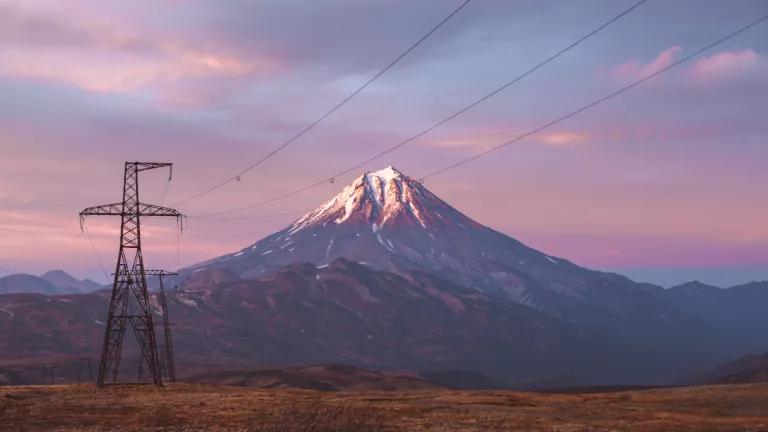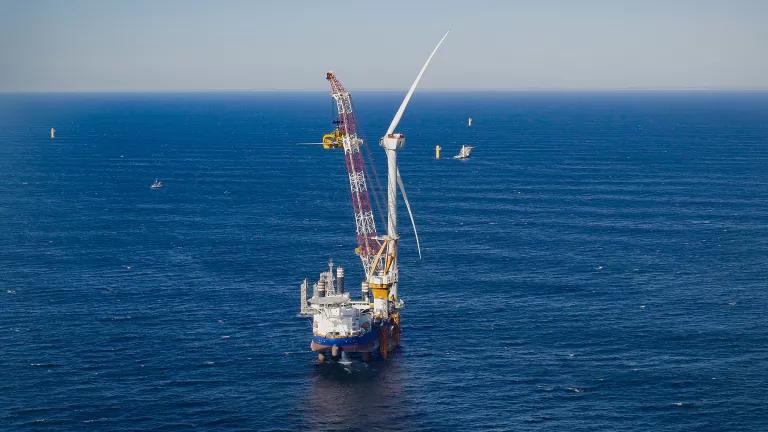After a Good Year for Transmission Reform, Hard Work Ahead
NRDC will continue to press regulators and lawmakers for policies that transition our power grid to a modern, robust, clean-energy electric delivery system.

Part of NRDC’s Year-End Series Reviewing 2022 Climate & Clean Energy Developments
This year saw the most consequential progress in how the U.S. plans for and builds transmission lines in more than a decade. Looking ahead to 2023 and beyond, NRDC will continue to press regulators and lawmakers for policies that accelerate the transition from our 19th-century power grid to a modern, robust, clean-energy electric delivery system.
Positive developments on transmission emerged from Congress, the U.S. Department of Energy (DOE), the Federal Energy Regulatory Commission (FERC), and regional grid managers. Those efforts must be accelerated if we are to lower the risk of blackouts caused by extreme weather and meet our goals for a healthy climate.
Upgrading our grid will allow renewable energy to connect sooner and to reach cities and towns where it is needed. The problem isn’t the availability of clean energy. There are about 1,235 gigawatts (GW) of new resources—primarily renewables and storage—waiting to connect to power grids across the country. That’s more than the combined output of all power plants operating in the United States today. But these projects face unconscionable delays in arcane interconnection queue processes first established decades ago that make it difficult for large numbers of smaller wind and solar plants to connect to the grid.
It is also vital to update transmission planning policies that have failed to accommodate a generational shift to renewable energy resources. Various estimates say we need to double or triple the rate at which we are building out the electric transmission system to deliver on the promises of the recently enacted Inflation Reduction Act. Longer, higher-capacity transmission lines that connect the whole country can provide grid operators access to potentially lifesaving electricity resources when generators are knocked offline during extreme weather or other events—boosting reliability and grid resilience. Finally, we need grid-enhancing advanced technologies to make the grid more intelligent and efficient.
FERC is moving in the right direction on transmission, but as it weighs changes it must ensure that projects undergo a rigorous regional planning process that includes minimum planning requirements. Such reforms would help to meet growing consumer demand for clean energy from wind and solar, boost grid resilience against ever-worsening extreme weather, and ensure that state and utility clean energy goals are met.
The good news is that we made progress in 2022 on interconnection and transmission:
- FERC is overhauling its transmission planning rules.
- FERC is working on a major rulemaking to help clear the interconnection backlog.
- FERC has issued two proposals that would put the utility industry in a better position to plan for and withstand extreme weather and help prevent blackouts.
- FERC just proposed promising changes to its existing transmission backstop siting rules (more on that below).
- Congress passed the 2021 bipartisan Infrastructure Investment and Jobs Act and the 2022 Inflation Reduction Act, which give the DOE new loan, grant, and other financing authorities to spur high-capacity transmission.
- The DOE is using new authorities in the infrastructure law to speed construction of high-capacity transmission lines with priority given to projects that improve grid resilience and reliability, facilitate interregional transfer of electricity, lower greenhouse gas emissions, and deploy advanced technology.
- FERC approved a proposal by PJM—the nation’s largest grid operator—to break a logjam preventing thousands of wind and solar power projects from getting built.
More work remains, especially at FERC. In addition to completing its regional planning and interconnection rules. FERC has long discussed updating rules that require transmission providers to plan for interregional transmission needs and for offshore wind. It must now move forward with proposing these rules. Fossil fuel apologists often complain that by shutting down dirty power plants too quickly, we’re compromising grid resilience. In reality, a resilient grid means that when a storm comes, the failure of any one power plant or other power sources can be overcome through a diverse array of clean energy assets, increased energy storage capabilities, and transmission lines to connect power sources to consumers across the country.
That’s what helped California survive a late summer record-breaking heatwave that stretched from Los Angeles to Denver, driving up demand for power. California is part of the Western Interconnection, a network that includes utilities from the Pacific to the Great Plains and north to parts of Western Canada. California’s ability to tap into power from distant sources that were unaffected by the heat wave helped save the day.
Adding connections between regions will help prevent blackouts and lower power costs. According to a recent study from GE Consulting, consumers in the Eastern U.S., could save $2 billion in electricity costs in 2023 and $4 billion in 2040 if more transmission lines moving power across states and regions are built. The study found that without the additions, existing transmission grid constraints could trigger power outages for 600,000 customers in New York City during an extended heat wave in 2035. No customers would lose power if the capacity to move more power across states and regions is expanded.
But efforts to promote long-haul transmission have stalled. That’s followed weak leadership from policymakers at all levels, mistrust among states and transmission regions, and the failure to fully account for the benefits of expanding interregional power lines. Virtually no major interregional transmission projects have been built in the U.S. in decades.
FERC recently held a workshop on establishing an interregional transmission transfer requirement. Such a requirement marks the first step towards improving transmission planning across regions. FERC must follow up and quickly propose rules on interregional transmission planning.
To fulfill the promise of a well-planned grid, transmission lines must actually get built. Existing law gives FERC and DOE backstop siting authority over certain large transmission lines. FERC just issued a proposed rule addressing backstop siting which I am hopeful will help worthy projects move forward by encouraging state cooperation and giving developers a more certain path. A Voluntary Code of Conduct included in the proposal designed to ensure developers are dealing in good faith is a good start—but dealing in good faith should not be voluntary. Landowners deserve more than that.
Other important steps are needed to move interregional lines forward. For instance, DOE must quickly issue its Transmission Needs Study and provide more information on how it plans to designate corridors on a route-specific, applicant-driven basis.
On another front, a coalition of environmental and social justice organizations have written President Biden recommending ways to accelerate clean energy deployment through the buildout of transmission lines.
These principles include a combination of proposed administrative and legislative action on how to identify and expedite key interstate transmission corridors, allocate costs in a fair manner, and conduct meaningful community engagement.
It amounts to a roadmap for building the transmission infrastructure we need to meet our climate goals while protecting impacted communities from harm by ensuring opportunities for meaningful and timely input.
Momentum is building. Congress has acted and federal regulators have taken important steps. But we can’t stop here. Now it will be up to Congress and officials at FERC and DOE to finish the job and ensure that states, public service commissions, grid operators, and utilities have the tools to deliver the clean, reliable, and resilient electrical system we want and need.



